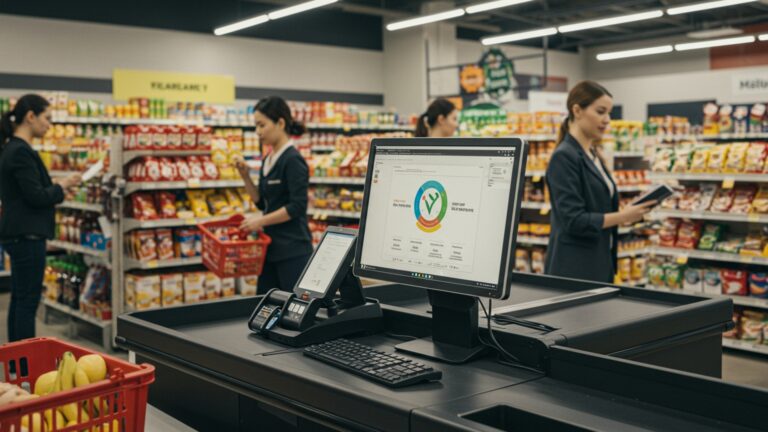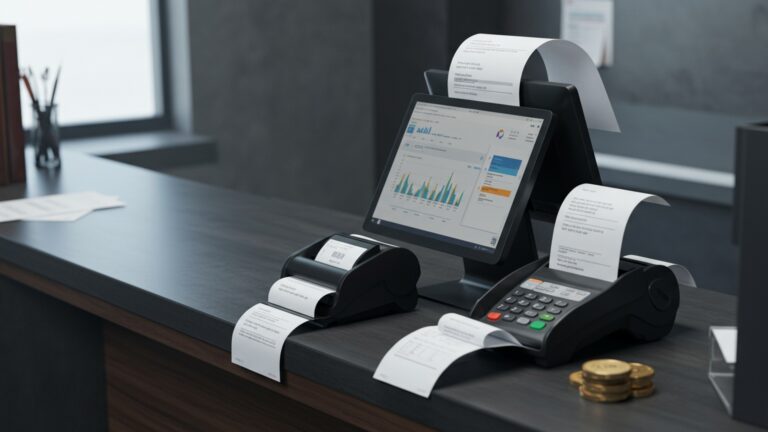How to Choose and Implement Cloud Based POS Software for Your Business
The retail and hospitality sectors are experiencing rapid transformation, driven by shifting consumer expectations and the imperative for operational agility. Traditional, on-premise Point of Sale (POS) systems often struggle to keep pace, creating bottlenecks for businesses aiming for seamless integration across online and physical channels, dynamic pricing. real-time analytics. This escalating need for modern, flexible infrastructure has made the adoption of advanced solutions non-negotiable. Here, cloud based pos software emerges as a pivotal technology, moving beyond mere transaction processing to become a central nervous system for modern operations, supporting everything from contactless payments and intricate inventory management to personalized customer experiences. Choosing and implementing the right platform is no longer a luxury but a strategic necessity for sustained growth and competitive advantage in today’s fast-evolving market.

Understanding Cloud-Based POS Software
In today’s fast-paced business environment, the way transactions are processed and managed has evolved dramatically. At the heart of this evolution lies the Point of Sale (POS) system. Traditionally, a POS system was a standalone terminal with local software, storing all data on-site. But, the advent of cloud technology has revolutionized this, introducing the concept of cloud based pos software.
A POS system, in its essence, is the place where your customer makes a payment for products or services. It’s the central hub for sales, inventory. customer management. When we add “cloud-based” to this, it means the software and all its associated data are hosted on remote servers, accessible via the internet, rather than being stored directly on your business’s physical hardware. This fundamental shift from local storage to a distributed, online infrastructure brings with it a host of advantages and transformative capabilities.
How does cloud based pos software work? Imagine your business data, from sales figures to inventory levels, residing not on a single computer in your back office. on secure, powerful servers maintained by a third-party provider (e. g. , Amazon Web Services, Google Cloud, Microsoft Azure). When an employee processes a sale, the insights is immediately sent over the internet to these cloud servers. This data is then processed, stored. made accessible from any internet-enabled device – be it a tablet, a smartphone, or a traditional desktop computer – anywhere in the world. This architecture ensures real-time updates and unparalleled flexibility.
Why Transition to Cloud-Based POS?
The move from traditional, on-premise POS systems to cloud based pos software is not just a trend; it’s a strategic business decision offering significant operational and financial benefits. Understanding these advantages is crucial for any business contemplating an upgrade.
- Scalability and Flexibility
- Accessibility and Mobility
- Cost-Effectiveness (OpEx vs. CapEx)
- Enhanced Data Security and Backups
- Real-time Analytics and Reporting
- Automatic Updates and Maintenance
One of the most compelling reasons to adopt cloud-based POS is its inherent scalability. As your business grows, whether you add new product lines, open more locations, or experience seasonal spikes in sales, a cloud system can easily accommodate increased demand without requiring significant hardware upgrades. You simply adjust your subscription plan. the vendor handles the infrastructure scaling. This flexibility is a game-changer for dynamic businesses.
With data stored in the cloud, business owners and managers can access critical sales data, inventory reports. employee performance metrics from anywhere, at any time, using any device with an internet connection. This empowers remote management, allows for pop-up shops. provides unparalleled oversight, even when you’re not physically present in your store.
Traditional POS often involves a substantial upfront capital expenditure (CapEx) for hardware, software licenses. installation. Cloud based pos software typically operates on a subscription model (Operating Expense or OpEx), spreading costs over time. This reduces the initial financial burden and makes advanced POS technology accessible to smaller businesses. Moreover, it eliminates costs associated with server maintenance, data backups. manual software updates.
Reputable cloud POS providers invest heavily in robust security measures, including encryption, firewalls. regular security audits, often surpassing what a small or medium-sized business could implement independently. Data is automatically backed up to multiple servers in different geographical locations, significantly reducing the risk of data loss due due to hardware failure, theft, or natural disaster. This offers peace of mind that your critical business data is safe and recoverable.
Imagine knowing your best-selling product, peak sales hours, or employee performance in real-time. Cloud-based POS systems excel at aggregating and analyzing data, providing instant insights into sales trends, inventory levels. customer behavior. This empowers data-driven decision-making, allowing you to optimize staffing, inventory. marketing strategies on the fly.
Unlike traditional systems that often require manual software updates and patches, cloud based pos software is updated automatically by the vendor. This ensures your system always has the latest features, security enhancements. compliance updates without any downtime or effort on your part, saving valuable IT resources and ensuring your system remains current.
Key Features to Look for in Cloud-Based POS Software
When selecting a cloud based pos software, the feature set is paramount. While core transaction processing is a given, the true value lies in the additional functionalities that streamline operations, enhance customer experience. provide actionable insights. Here’s a breakdown of essential features:
- Inventory Management
- Customer Relationship Management (CRM)
- Employee Management
- Reporting and Analytics
- Multi-Location Support
- Payment Processing Integrations
- E-commerce Integration
- Offline Mode Capabilities
- API and Third-Party Integrations
A robust inventory system is non-negotiable. Look for features like real-time tracking, low-stock alerts, purchase order management, vendor management. multi-location inventory synchronization. This helps prevent stockouts, reduces carrying costs. improves supply chain efficiency.
Beyond just processing sales, a good cloud POS should help you build customer loyalty. Features like customer profiles, purchase history tracking, loyalty programs, gift card management. targeted marketing capabilities allow you to grasp and engage with your customers more effectively.
Efficiently manage your workforce with features such as time clock functionality, shift scheduling, performance tracking, commission calculation. role-based access controls to secure sensitive data.
This is where cloud POS truly shines. Seek comprehensive reporting on sales performance, product profitability, customer trends, employee productivity. inventory turnover. Customizable dashboards and exportable reports are highly valuable for strategic planning.
For businesses with more than one store, centralized management is critical. The system should allow you to manage inventory, employees. sales data across all locations from a single dashboard.
Seamless integration with various payment processors (credit cards, debit cards, mobile payments, contactless payments) is essential. Ensure the system supports EMV compliance and offers competitive processing rates.
In an omnichannel world, your online and in-store sales should ideally sync. Look for direct integrations with popular e-commerce platforms (e. g. , Shopify, WooCommerce) to ensure unified inventory, customer data. sales reporting.
While cloud-based, a reliable system should offer an offline mode. This allows transactions to continue processing even if the internet connection drops, with data syncing back to the cloud once connectivity is restored, preventing lost sales.
No POS system can do everything. The ability to integrate with other essential business tools – such as accounting software (e. g. , QuickBooks, Xero), marketing automation platforms, or specialized loyalty programs – through an Application Programming Interface (API) is crucial for a cohesive business ecosystem. For example, a simple API call might look like this for updating inventory:
POST /api/v1/products/update_inventory Host: yourcloudpos. com Content-Type: application/json { "product_id": "SKU12345", "new_quantity": 50, "location_id": "STORE_NY" }
This allows other systems to interact programmatically with your POS, extending its capabilities.
The Selection Process: A Step-by-Step Guide
Choosing the right cloud based pos software is a critical decision that can significantly impact your business’s efficiency and profitability. A methodical approach ensures you select a system that aligns perfectly with your specific needs.
- Assess Your Business Needs
- Identify Current Pain Points
- Define Future Goals
- List Essential Features
- Consider Your Industry
- Budgeting Considerations
- Subscription Costs
- Hardware Costs
- Transaction Fees
- Setup and Training Costs
- Research and Vendor Shortlisting
- Start by researching reputable cloud based pos software providers known in your industry. Look for vendors with a strong track record and positive reviews.
- Create a shortlist of 3-5 vendors that appear to meet your core requirements.
- Demo and Trial Periods
- Schedule personalized demos with each shortlisted vendor. Ask specific questions related to your business needs.
- Take advantage of any free trial periods offered. This hands-on experience is invaluable for testing features, ease of use. overall workflow. Involve key staff members in the trial to gather their feedback.
- Evaluate Support and Training
- What kind of customer support is offered (24/7, phone, email, chat)?
- What training resources are available (online tutorials, webinars, in-person training)?
- A reliable support system is crucial, especially during implementation and in case of technical issues.
- Read Reviews and Case Studies
- Consult independent review sites (e. g. , Capterra, G2, Software Advice) and industry-specific forums.
- Look for testimonials and case studies from businesses similar to yours. Pay attention to both positive and negative feedback regarding reliability, support. specific features.
- Security and Compliance Checks
- Inquire about the vendor’s data security protocols (encryption, data center security, compliance certifications like PCI DSS).
- comprehend their data backup and disaster recovery plans. Your business’s data integrity is paramount.
What are the biggest challenges with your current system (or lack thereof)? Slow transactions, inaccurate inventory, difficult reporting, limited payment options?
Do you plan to expand, launch an e-commerce store, or implement a loyalty program? Your POS should support these aspirations.
Based on the previous section, create a prioritized list of “must-have” and “nice-to-have” features for your specific business type (retail, restaurant, service).
Different industries have unique requirements. A restaurant needs table management and kitchen display system integration; a retail store needs robust inventory and barcode scanning.
comprehend the monthly or annual fees. Are there different tiers based on features, users, or locations?
While cloud-based, you’ll still need hardware (tablets, receipt printers, barcode scanners, cash drawers). Factor these into your budget.
Clarify payment processing rates and any additional fees.
Some vendors charge for implementation and initial staff training.
Implementing Your Cloud-Based POS System
Once you’ve chosen the ideal cloud based pos software, the implementation phase is critical for a smooth transition and successful adoption. A well-planned implementation minimizes disruption and maximizes the return on your investment.
- Data Migration Strategy
- Inventory Data
- Customer Data
- Historical Sales Data
- Clean and Organize
- Hardware Requirements
- Identify and procure necessary hardware:
- POS Terminals
- Receipt Printers
- Barcode Scanners
- Cash Drawers
- Payment Terminals
Tablets (iPad, Android), laptops, or dedicated POS stations.
Thermal printers are common. Ensure compatibility.
Handheld or integrated.
Connectable to the receipt printer or directly to the POS terminal.
EMV-compliant card readers for secure transactions.
- Ensure reliable internet connectivity in all areas where the POS will be used. Consider backup internet options.
- Staff Training
- This is arguably the most crucial step. Even the best system is ineffective if staff can’t use it.
- Develop a comprehensive training plan. Start with a small group of super-users who can then train others.
- Cover all aspects: processing sales, managing returns, applying discounts, checking inventory, opening/closing shifts. basic troubleshooting.
- Provide hands-on practice in a non-live environment.
- Emphasize the benefits of the new system to foster enthusiasm and reduce resistance to change.
- Pilot Testing
- Before a full launch, conduct a pilot test in a controlled environment or during off-peak hours.
- Process a few actual transactions, test different payment methods, returns. loyalty programs.
- Identify and resolve any unforeseen issues or workflow bottlenecks.
- Gather feedback from staff involved in the pilot.
- Go-Live and Post-Implementation Support
- Choose a go-live date when you anticipate lower traffic, if possible.
- Have vendor support readily available during the initial days.
- Designate internal “champions” who are proficient with the new system to assist colleagues.
- Continuously monitor performance, gather feedback. address any lingering issues promptly.
- Regular Performance Monitoring
- Once live, regularly review your POS reports and analytics.
- Track key metrics like average transaction value, sales by product. inventory turnover.
- Use these insights to refine operations, identify opportunities for improvement. ensure you’re maximizing the value of your cloud based pos software.
Prepare your existing product list, including SKUs, descriptions, pricing. stock levels, for import. Most cloud POS systems offer bulk import functionalities via CSV files.
If you have an existing customer database, plan how to migrate names, contact details. loyalty points.
Decide if you need to import historical sales data for reporting continuity.
Use this opportunity to clean up old data, remove discontinued items. standardize product categories.
Real-World Applications and Success Stories
The versatility of cloud based pos software makes it suitable for a wide array of businesses, from small boutiques to large restaurant chains. Its real-world impact is best illustrated through practical examples.
Case Study 1: The Expanding Coffee Shop Chain
Consider “Brew & Bloom,” a local coffee shop that decided to expand from one location to three within two years. Initially, they used a basic traditional POS system. But, managing inventory, sales. staff across multiple locations became a nightmare. They switched to a cloud based POS software. The immediate benefits were profound:
- Centralized Management
- Consistent Pricing
- Employee Flexibility
- Scalability
The owner could view real-time sales data from all three shops on a single dashboard from home. Inventory transfers between stores became trackable, reducing waste.
Menu updates and pricing changes could be pushed to all terminals simultaneously, ensuring consistency.
Staff could log in at any location. their time clock and performance were tracked centrally.
Opening the third location was seamless, requiring only the purchase of new hardware and a quick setup on the existing cloud platform, rather than installing entirely new server infrastructure.
Case Study 2: The Mobile Pop-Up Boutique
“Wanderlust Apparel” is a fashion boutique that operates primarily through pop-up events, festivals. online sales. A traditional POS was out of the question due to mobility constraints. Their adoption of a cloud based pos software running on iPads transformed their business model:
- Untethered Sales
- Real-time Inventory Sync
- Offline Capabilities
- Customer Engagement
Sales associates could process transactions anywhere, from the front of the booth to the dressing room, using a tablet and a mobile card reader.
Online and in-person sales automatically updated inventory, preventing overselling and ensuring accurate stock counts across all channels.
At outdoor festivals with spotty Wi-Fi, the POS seamlessly switched to offline mode, storing transactions locally and syncing them once an internet connection was re-established.
They could capture customer emails at events and immediately add them to their loyalty program, linking their in-person purchases to their online profiles.
Industry experts, like those at Forrester Research, frequently highlight the shift towards cloud-based solutions as a cornerstone of modern retail technology. They emphasize that “the future of POS is undoubtedly in the cloud, driven by the need for agility, data insights. seamless omnichannel experiences.” This sentiment is echoed across various sectors, underscoring the importance of selecting a robust cloud based pos software for competitive advantage. The ability to integrate with emerging technologies like AI for personalized recommendations or IoT devices for smart inventory management further solidifies the cloud’s role as the foundational platform.
| Feature | Traditional POS | Cloud-Based POS |
|---|---|---|
| Data Storage | Local server, on-premise | Remote servers (cloud), accessible via internet |
| Accessibility | Limited to local network, on-site | Anywhere, anytime, any device with internet |
| Cost Structure | High upfront CapEx (hardware, software license) | Subscription-based OpEx (monthly/annual fees) |
| Updates & Maintenance | Manual, often requiring IT staff or downtime | Automatic, managed by vendor, seamless |
| Scalability | Challenging, often requires significant hardware upgrades | Highly scalable, adjusts with subscription plan |
| Data Security | Relies on internal IT, vulnerable to local issues | Robust vendor security, professional backups, disaster recovery |
| Real-time Reporting | Limited, often requires manual data extraction | Instant, comprehensive analytics and dashboards |
| Integrations | Can be complex, expensive, limited | Extensive APIs, easier integration with third-party apps |
Conclusion
Choosing and implementing cloud-based POS software is a pivotal strategic decision, transforming your business from reactive to proactive. Remember, the true power lies not just in processing transactions. in harnessing real-time data for inventory accuracy, customer insights. seamless multi-channel operations. My personal tip for success is to involve your front-line staff early in the selection process; their input on daily workflows is invaluable for smooth adoption. As the retail landscape rapidly evolves with trends like unified commerce and mobile payments, a robust cloud POS ensures you’re not just keeping pace. leading. Don’t hesitate to pilot test your chosen solution rigorously, perhaps focusing on a single location or specific product line first, to iron out kinks before a full rollout. Embrace this journey with confidence; the right cloud POS will empower your team, delight your customers. unlock unprecedented growth for your business.
More Articles
A Practical Guide to Implementing Cloud Based POS Software Seamlessly
Master Choosing the Best POS Software in India for Your Business Needs
Mastering POS Software How to Optimize Business Operations for Efficiency
How to Select the Perfect POS Software for Your Retail Store
Learn How to Master POS Billing Software for Faster Sales and Efficiency
FAQs
What exactly is cloud POS and why would my business need it?
Cloud-based POS (Point of Sale) software runs on remote servers and is accessed over the internet, rather than being installed directly on your hardware. This means you can manage sales, inventory. customer data from anywhere, on any device with an internet connection. Businesses love it for the real-time insights, lower upfront costs, automatic updates. better scalability compared to traditional systems.
How do I figure out which cloud POS system is the best fit for my specific business?
Start by listing your essential needs and ‘nice-to-have’ features. Consider your industry (retail, restaurant, service?) , transaction volume, inventory complexity. number of locations. Look for a system that’s easy for your staff to use, offers robust reporting, integrates with your other tools (like accounting). fits your budget. Don’t forget to check customer reviews and vendor support quality.
What are the absolute must-have features in a cloud POS?
At a minimum, you’ll want solid sales processing (including refunds/exchanges), comprehensive inventory management, customer relationship management (CRM) capabilities. detailed reporting. Other key features often include employee management (time tracking, permissions), multi-location support, mobile access. integrations with payment processors and e-commerce platforms.
Is setting up a new cloud POS system a huge headache, or is it pretty straightforward?
It can be surprisingly straightforward, especially with a good vendor. The process usually involves importing your existing product and customer data, setting up any necessary hardware (like barcode scanners or receipt printers), configuring settings specific to your business. training your staff. The biggest time-saver is often vendor support during data migration and training. Planning ahead is key!
How secure is my business data when it’s all in the cloud?
Reputable cloud POS providers invest heavily in security measures that often surpass what a small business could implement on its own. They use advanced encryption for data in transit and at rest, secure data centers, regular backups. strict access controls. Always choose a vendor with a strong security track record and transparent policies to ensure your data is protected.
Can a cloud POS system talk to my other business tools, like accounting or e-commerce?
Absolutely. this is one of its major benefits! Most modern cloud POS systems offer integrations with popular accounting software (like QuickBooks or Xero), e-commerce platforms (like Shopify or WooCommerce), CRM systems. loyalty programs. These integrations automate data transfer, reduce manual entry errors. give you a more unified view of your business operations.
What kind of ongoing costs should I expect with cloud POS software?
The primary ongoing cost is typically a monthly or annual subscription fee, which varies based on features, number of users. locations. You might also have transaction fees from your payment processor. there could be additional costs for premium support, advanced features, or specific hardware if you need to purchase or lease it. Always clarify all potential fees before committing.






